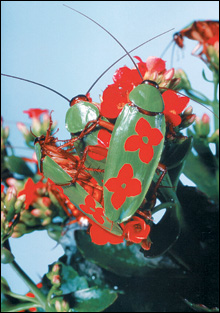
POP BEETLES: You don’t have to know the punch line to appreciate Catherine Chalmers’s costumed cockroaches.
|
So thorough and deadpan is the joke that Catherine Chalmers pulls off in her ravishing color photographs of insects crawling across flowers they resemble that when I read the wall text I was sure there had been a mistake. The text talked about her cockroach series and the “fictive scenarios” she creates by employing mail-order cockroaches, but where were they? In one photo, a bug I’d never heard of, the peacockroach, displays the dazzling plumage, feathery and iridescent, of the bird it’s named for. In another, black and yellow bumblebees with unusually large antennae amble across a brilliant sunflower of the same contrasting hues. In a third, ladybugs in their traditional finery of black spots on red surfaces inspect the blossom of a leafless red and white flower. That the ladybugs were elongate and sported antennae larger than their bodies only meant I wasn’t familiar with all the variants of the species. Even the pop beetles with their ’60s-style pattern of simplified blossoms on their backs raised no suspicions: who hasn’t beheld with awe the ingenious camouflage of not dissimilar creatures in the pages of National Geographic?
It took the patient good humor of the DeCordova Museum’s publicist to explain what I had failed to see: all the insects were in fact cockroaches that the artist had meticulously painted, outfitted, and positioned. The joke was on me. Yet grateful as I was to have been arrested in my gullibility, and impressed as I am by Chalmers’s rich artistic sensibility, her “American Cockroach” photos and the estimable contributions by a few other artists are not sufficient to make “Going Ape” more than a mostly silly, frequently inept, and decidedly unconfrontational treatment of a well-worn (but hardly worn-out) theme: animals as the subject of artistic imagemaking.
One problem with the exhibit is that all the still works — paintings, photographs, installations, and sculptures — are just animals, with the exception of Komr & Melamid’s contribution, two acrylic paintings they coaxed elephants into making by holding a paintbrush in their trunks. The result of keeping humans out of the pictures and 3-D works is that none of our interactions with what remains of the beasts and the birds and the bees has been allowed in. Instead, we get the museum version of a zoo. Onlookers only, we’re invited to stare at animal forms that are as removed from their meanings and contexts as the caged cats at Franklin Park.
The other problem is the overwhelming sense of cute.
James Grashow’s network of square-faced cardboard interlocking monkeys cascades from the ceiling of the museum’s great staircase. They’re chimpanzee-sized and draping from one another’s arms, as if Curious George had metastasized as a garland. I’m not sure what Grashow was after beyond the effect of the nursery mobile — The Great Monkey Project could well delight the infant and toddler and pre-schooler. Would that the appeal went farther, or that the curators had packaged the exhibit for what it so frequently is, the fine-art version of the Museum of Science.
ADVERTISEMENT
 |
There are, of course, many kinds and degrees of sweetness, some cloying, others subtle. Among the former have to be included Barbara Moody’s dark charcoal drawings of doe-eyed goats and dreamy-eyed rabbits. They stare into each other’s eyes like troubled lovers; I kept wondering what children’s book they had been commissioned for. Peter Smuts, whose ambition deserves praise, takes toy animals, submerges them in water, and creates large, color-saturated photographs distorted in places ever so slightly by the refraction of light through their aqueous homes. You can tell the artist has invested great meaning here by the scale (36x54) and the strained intensity of the pictures, with their focus on the animals’ visages. But that meaning does not translate; the provocation they intend to pack feels lighthearted, the threat feels rehearsed — bar banter rather than a real argument. It doesn’t matter that the zebra’s oversized eyes make it look as if it were about to be hit by a truck, or that the surrounding wash of throbbing yellow might emanate from a nuclear hit. It’s still a toy.